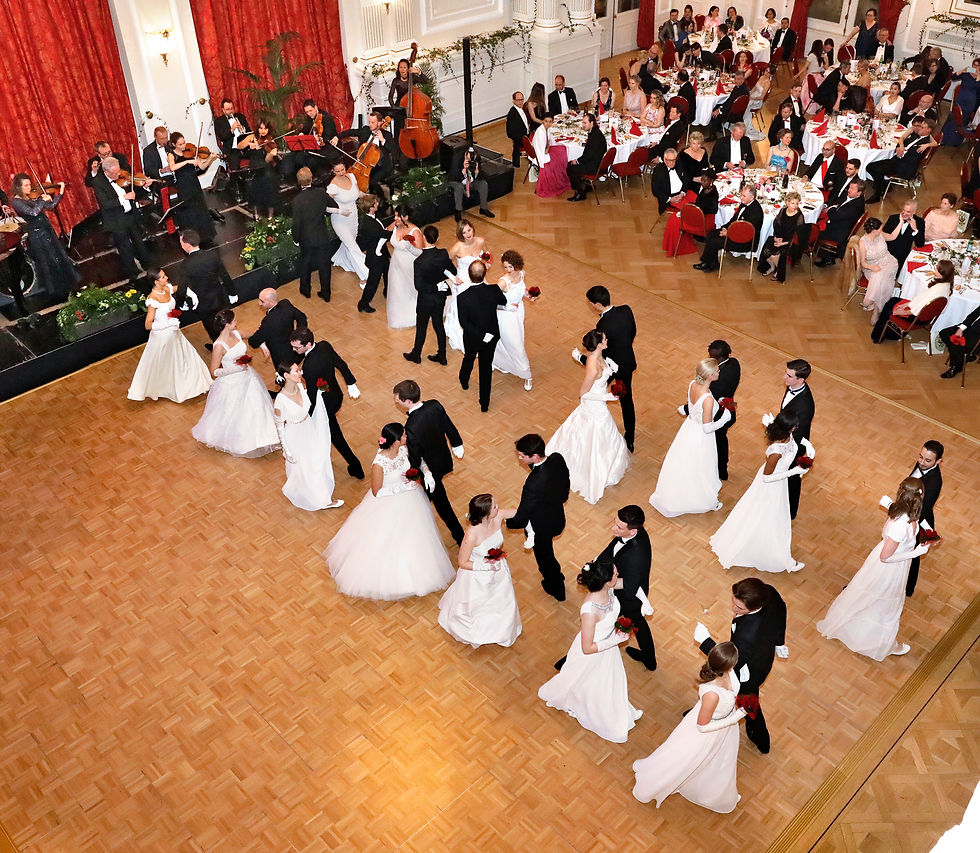
Viennese Ball Tradition
The traditional Wiener Ball developed from social events which were held at the French and Burgundian court in the fourteenth century, and during which dancing also took place. The high point was reached in the ball evenings of the Viennese Biedermeier period, between the Congress of Vienna in 1814/1815 and the revolution of 1848.
After all the shortages of the war years before the Congress of Vienna, people were desperate to enjoy themselves again. Under the regime of von Metternich the population was excluded from all political decision-making, but while the spoken and written word were subject to restrictions, music was not censored. It was then that the Viennese waltz was born, and its notes still define the musical programme of every Viennese ball today.
Johann Strauss the Elder (1804-1849) and Josef Lanner (1801-1843) are held to be the Viennese ball's founding fathers and the "Waltz Kings". But what was (and is) the fascination of this "new" type of musical entertainment?
In contrast to older types of social dances, the waltz, with its fast whirling of partners held as if in a close embrace, shocked polite society when it was first introduced. In the second half of the 19th century, Johann Strauss the Younger (1825-1899), his brothers Josef (1827-1870) and Eduard (1835-1916), Carl Michael Ziehrer, and many others helped to develop and spread the waltz.
Just like his father before him, Johann Strauss the Younger soon became known as a "Waltz King". In addition to the Kaiserwalzer(Emperor Waltz), Wiener Blut (Viennese Blood), and the G'schichten aus dem Wienerwald (Tales from the Vienna Woods), he also composed what is surely the most famous of all waltz melodies, An der schönen blauen Donau, the "On the beautiful blue Danube".
Ever since then, the pleasant and convivial atmosphere of balls has not only been used for dancing but also as an opportunity to rekindle personal or professional contacts, or to make new ones. Decisions of world importance are no longer made during balls these days, like they were at the "dancing" Congress of Vienna, but the most famous of all Viennese balls, the Opera Ball, still attracts pre-eminent personalities from politics, business, and society.
Balls are still a distinct feature of Viennese carnival celebrations. Most of the 250 or so balls which take place during the "ball season" are held in venues steeped in history. But it is not only in Vienna that the tradition of typical Viennese balls is kept alive; such events take place throughout the world. These events also help to cement the international reputation of Vienna as a cultural capital.
A typical ball always begins with a ceremony which has developed from 18th century Viennese court ceremonial.
Every lady is greeted on entry to the ballroom and given a small gift, the so-called Damenspende.
The actual opening ceremony begins with the entry of a "debutante committee", as it is known in Vienna, whose members form up to the sounds of a polonaise (usually by Carl Michael Ziehrer). The conductor gives the upbeat for a quadrille which is then danced by the young ladies and gentlemen. All the young ladies who open the ball evening must wear a long white gown. The young men wear either dinner suit or evening dress (tails) at all important balls. When the two groups of ladies and gentlemen dance in the opening ceremony it creates the most wonderful contrasting black and white patterns.
The opening ceremony ends with a "left hand waltz" (where the movement is solely to the left).
Up until this point, only the young ladies and gentlemen of the debutante committee are on the dance floor. But then the dancing master invites all other guests to join the dancing with the words "Alles Walzer" (waltz for all).
Although the waltz is the main part of the musical programme during a ball, there is also a chance to dance other dances such as the foxtrot, slow foxtrot, "slow" waltz, rumba, or cha-cha-cha.
However, the most important aspect of any traditional ball is that all guests remember it as a superb experience long after they have gone home!



